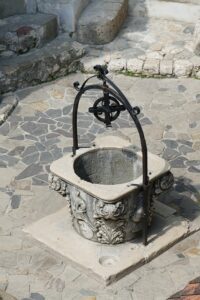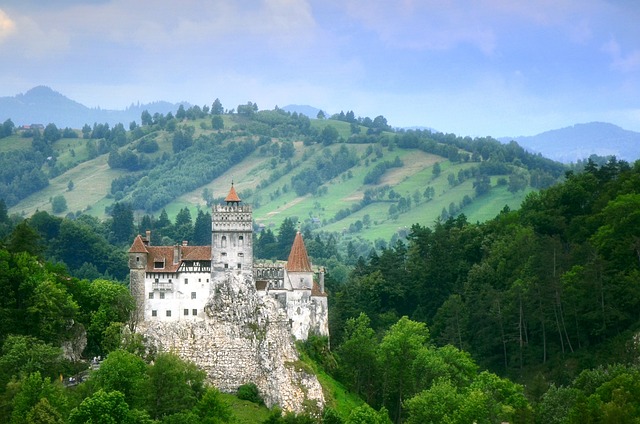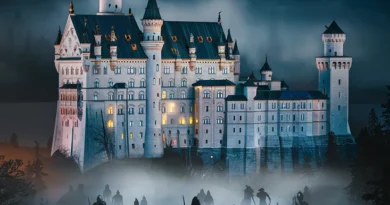Bran Castle: Not Really Dracula’s Castle, But Still Worth It
It’s hard to find a horror fan who doesn’t know Dracula. Even if the current generation hasn’t read Bram Stoker’s 1897 gothic novel, you’re familiar with the somewhat inspired vampire character of Vlad III’s Dracula. The one who was cruel ruler of Valkaia is best known as “Vlad the Impaler,” and he was nicknamed because of his hobby of impaling people to death. To this day, we come across countless references to Dracula – starting with horror movies (“The Invitation,” which we reviewed here not long ago, or “Renfield,” which is coming to the cinema right now), through songs or children’s programs (the successful film series “Hotel Transylvania” which can be your children’s start in the world of horror or even Count Mikula from Mickey Mouse’s Friends Club that the girls see in our reruns), to a wide variety of costumes and other products. Many of these contents mention Bran Castle, also known as Dracula’s castle.
All this, we are still determining if this castle has any real connection to Dracula or even to the historical figure from which the count drew inspiration. So is this a place branded as such for tourist purposes, but is it a tourist trap? And how can you even visit here?
Dracula’s Castle: The Beginning
Where is Bran Castle located? Unsurprisingly, Bran Castle is located in Bran, between Transylvania (equally associated with Dracula) and Montana. Bran Castle history begins as far back as the 13th century, several hundred years before you can connect it to THAT vampiric gothic figure. It was founded as early as 1212 by the members of the Teutonic Order as the “Wooden Castle of Dietrichstein.” It was intended to serve primarily as a fortified position near a mountain pass used by traders for thousands of years. In other words: in its beginnings, Count Dracula’s Castle was a fortress.
In 1242, the Mongols destroyed it under the command of Genghis Khan. We continue to the 14th century when the castle was rebuilt – this time in stone – after receiving permission from Melius I, King of Hungary. The main goal was to protect the border of Transylvania and stop the expansion of the Ottoman Empire in the region. Laiush tried to encourage the locals to build a castle independently with their funding and offered an exemption from taxes for a very long period. The castle was built and took part in the local defense equation in the war against the Ottoman Empire. At the same time, the Bran region began to prosper, much thanks to the castle. The problem is that the ravages of time also began to be present in it. The Castle was destroyed several times due to the obsolescence of the material, the weather, and other reasons.

💀 Killer Deals & Scary Recommendations 💀
🎭 Costumes & Accessories
HalloweenCostumes Fun Costumes Entertainment Earth
🛒 Online Shopping
AliExpress Amazon Walmart Etsy
🧛 Collectibles & Horror Brands
Funko Hot Topic Lego Spirit Halloween
🎢 Attractions & Tours
GetYourGuide Tiqets Viator Klook
📖 Blogs & Horror Sites
Bloody Disgusting iHorror Fangoria
🩸 Disclaimer: Some links are affiliate links. The price stays the same – it just helps keep the site alive 👻
Who Lived In Bran Castle?
Without going too much into historical details, which you can read about on Dracula’s Castle’s official website or during your visit, we will tell you that the castle has changed “hands” quite a few times since then. Among other things, Bran Castle Transylvania was held by the old Mircea (ruler of Wallachia, who received the nickname not because he was ancient but to distinguish him from his son) and later the residents of Brasov. The Queen of Romania received the building in 1920 as a gift and saw its purpose as a castle. She renovated it for no less than 14 years and turned it into the official summer residence of the royal family. She replaced the small door (designed in advance with small dimensions to make it difficult to penetrate the fort) with an impressive and much larger oak door.
Right before her death, she asked her daughter – Princess Ileana – to take her heart out of her body and bury it in the Belcek Castle near the Black Sea. Following wars and changes of governments in the region, Queen Marie’s heart wandered between different locations. It was stored for a time in Bran Castle, but with the rise of Communism, it changed its place to Plisor Castle, also in Romania. Today you can find it in a small urn on the stream’s banks southwest of Bran Castle.
Princess Ileana continued to nurture the castle. In World War II, however, the horrors of war also reached the Transylvania region. That princess, who trained as a registered nurse, decided to turn the castle into a temporary hospital to treat soldiers injured on the battlefield: for example, soldiers who were staying at the Red Cross hospital in Barshav, bombed by the American army. She called it the “Hospital of the Queen’s Heart” and treated some patients herself. In 1948, the communists seized the castle, and it returned to the Romanian authorities only in 2006. Dominic von Habsburg, the son of the heiress Ileana, was the one who received the reins.
In 2007, Bran Castle Romania was offered for sale, but this step did not materialize. At this stage, they decided on a solution to turn it into a first-class tourist spot: turning it into a museum and, most importantly – branding it as Dracula’s castle in Romania.
Dracula’s Castle? Well, Kind Of…
The decision to turn Bran Castle into a museum completely changed the castle’s status, or even tourism in Romania in general and Transylvania in particular. The castle was the first private museum in Romania, and it displayed, among other things, pieces of art, weapons, and costumes from all its history. This fact can explain why some people visit it, but certainly not the swarm of tourists, making it the number one tourist attraction in Romania.
The castle is so famous, for sure, since it connects to Dracula. But is there even a connection between Castle Bran and Dracula, or even Vlad the Impaler, on whom the character is based? And did Vlad the impaler live in bran castle? If you ask the best historians, the answer is complex. Vlad III never visited the castle or impaled people there. A few hundred years ago, many believed he was imprisoned there during the 15th century. Today some believe that he was detained in the fortress in Budapest or, at most, only spent two months in Bran Castle. Either way, he is connected to the Transylvania region and was as cruel a ruler as described.
The castle is not mentioned in the novel “Dracula” by Bram Stoker. However, the court described here looks similar: a castle in the Transylvanian region made of stone and located on a rock high above a green valley under which a river runs. In Transylvania, there is one castle that meets this definition, and that is Bran Castle. But the Irish writer Bram Stoker never stepped inside Dracula’s castle or Romania. According to the standard theory, he described the castle based on pictures he got.
The Secrets of Bran Castle Inside: From Ghosts to Hidden Passages
Contrary to what some people think, Bram Stoker may have invented Dracula – but not the vampire character. His roots may be very close to Bran Castle, similar to the castle described in Chapter 2 of the Gothic masterpiece. Romania decided to market it as “Dracula’s Castle” for tourist purposes, thanks to the Gothic appearance, the dramatic architecture, the connection (however slight) to Vlad the Impaler, or even the first images of the castle they created in American cinema.
When you create such a myth around a castle, you can expect it to continue and grow over the years. The horror stories have accompanied Dracula’s castle since then to this day. They say it is haunted. Those staying there alone at night will likely encounter ghosts and unsympathetic creatures. Some of these myths stem from the local belief that there are demons (“Strigoi”) who have risen from the dead. Legend has it that those spirits were “normal” during the day, but at night they were taken over by evil spirits that caused them to feed on the blood of their victims. Yeah, you know, like vampires. Another myth is that the character of Dracula is based on another terrible historical murderer, Countess Elizabeth Bathory. The Hungarian “Bloody Countess,” who lived in the late 16th century, is believed to have murdered hundreds of teenage girls after torturing them. According to local folklore, she used to murder virgin girls with their blood because she thought that through their blood, she would be able to stay beautiful and young.
Like other gothic historical castles, Bran Castle also has its secrets. One of them is Bran Castle’s secret passage. During the massive castle renovations during Queen Mary’s time, on its 57 rooms (at least), the renovation workers suddenly discovered a secret route connecting the  first and third floors. The castle’s people initially intended to use the staircase for a quick escape in an emergency, and they hid it behind a false fireplace. This secret passage was forgotten for hundreds of years until it was discovered inside Bran Castle during the renovations.
first and third floors. The castle’s people initially intended to use the staircase for a quick escape in an emergency, and they hid it behind a false fireplace. This secret passage was forgotten for hundreds of years until it was discovered inside Bran Castle during the renovations.
Outside the castle, you will find a well. But this is not well used for its primary purpose: a facility that extracts water from the ground. This well is an elevator built for Queen Mary when she encountered difficulty moving between levels due to her advanced age. This elevator was extended to connect to the royal gardens and make it easier for the Queen to her mobility.
Should You Visit Dracula’s Castle?
Even if it does not necessarily have a direct connection to Dracula, there is no doubt you should consider seeing the castle during the visit to Romania. The castle is beautiful, well-preserved, and in an excellent location, which you can see from its windows and turrets.
The castle includes enough information to make the visit enjoyable, although many items are restored (for example, weapons or armor). Please note, however, that most of the information deals with the history of Bran Castle and not with the character of Dracula. If you expect an attraction like the “Dracula Museum,” you may be disappointed. There are a few Dracula-related items, mostly pictures, but nothing unusual.
If you come to the castle, we recommend joining a guided tour that will allow you to learn everything essential and exciting about it and understand what you see. Beyond the well-preserved or restored items, it has some interesting points. The time tunnel is a tour made in special elevators, which creates a feeling of going back in time with the help of multimedia presentations. You will find a small exhibition showing the threatening side of Transylvania, including some horror stories, urban legends, instruments of torture, creepy art objects, and more.
One of the main complaints from visitors is that the crowd makes the visit less appealing. Part of the charm of visiting an old and gothic place, certainly one with mysterious stories surrounding it, is lost when you need help finding a place in the castle among the crowds of tourists or waiting a long time in queue. To solve this, we recommend coordinating the visit to less busy times:
- The morning hours (before the organized groups arrive).
- Mid-week days.
- Outside the “hot” months in Romania’s tourist calendar.
Bran Castle Tours
It is advisable to buy Bran Castle tickets even earlier, even online – don’t worry, the big websites offer a free cancellation option up to 24 hours before – thus avoiding the queue at the entrance, which can be tiresome due to the vast number of tourists or the fact that the passages and doors here are pretty narrow. Hence, it’s easy for a queue to build up around them.
Bran Castle Entrance Ticket
Bran Castle Guided Tours
Another option is to book a guided tour, which lasts about an hour. This option is more expensive, obviously, but it will allow you to experience more of the place.
Day Trips
Bran Castle Location makes it accessible from the main cities in Romania. Exciting day trips depart from Bucharest and other cities in Romania, some of which combine other attractions: a trendy trip combines Bran Castle, Peles Castle, and Brasov. Bran Castle tours from Bucharest last about 12 hours, quite a bit of it by driving, but if you are in the capital of Romania and want to taste the castle – you should dedicate a day to it.
And by the way, even near the castle, you will find enough to do, for example, well-kept gardens, restaurants, and stalls selling local delicacies and souvenirs.
Here are some of the day trips to Bran Castle from Bucharest, Barsov and more:
How Do You Get To Bran Castle?
Bran Castle is about 30 km from Brasov and about 160 km from Bucharest. To get from Brasov to Bran Castle, you can take a bus of about 45 minutes to the castle, which leaves once every hour or half an hour, for a nominal price. From Bucharest, the journey to it is more challenging. You will first have to go to Brasov by train for over three and a half hours, and from Brasov, make the way to the Bran castle.
Of course, it is possible to arrive by public transportation or rental car as part of an organized tour departing from one of these cities. There are enough paid parking lots around the castle, while those who want free parking based on available space can look for parking in the village of Bran, from where you can reach the castle with a walk that is short. You will find the instructions for arriving at the castle here.
Bran Castle Opening Hours
Bran Castle’s opening hours may change throughout the year, and we recommend doing a basic check before you think of coming here. The castle is usually open Tuesday through Sunday from 6:00 p.m. to 9:00 a.m. (last entry at 6:00 p.m.) and Mondays from 6:00 p.m. to 12:00 a.m. (last admission at 6:00 p.m.).
How Long Does The Castle Tour Last?
You should devote about 45-60 minutes to the castle tour. The guided tours held here last about an hour.




